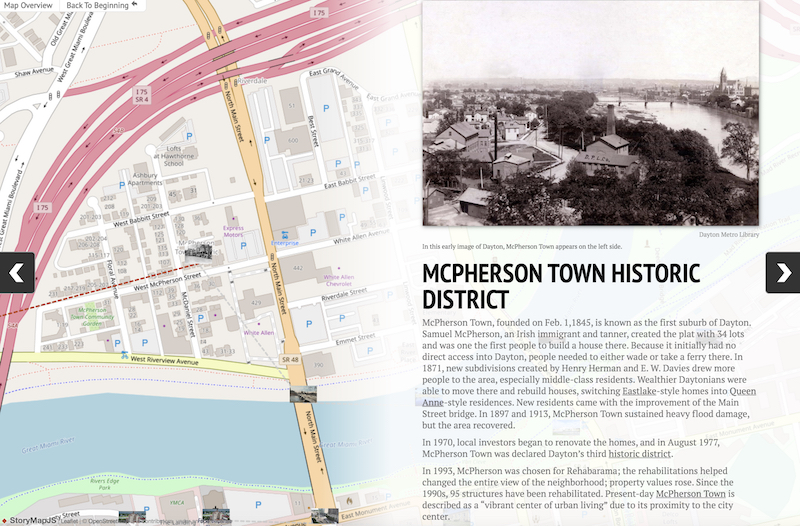University Libraries

Experiential Learning Innovation: An Online Educational Tour of Downtown Dayton
A passion for Dayton, a love of history and an engagement with digital humanities combined to help students in a first-year writing seminar, English 114, create an online walking tour of downtown Dayton.
It started as an idea to convert an existing print copy of a neighborhood walking tour into a digital format on a platform called StoryMapJS, which allows users to place “pins” on a map with accompanying information such as photos, descriptions, coordinates and web links. It turned into an opportunity to explore even more than that. Using support from the Experiential Learning Innovation Fund for Faculty (ELIFF), English lecturer Joe Craig, librarian Heidi Gauder and archivist/librarian Kayla Harris teamed up to help Craig’s students learn more about the city around them — all remotely.
Research through geographic, demographic, social lenses
In the first part of the semester, students examined social issues such as housing and food access within the context of Dayton. During the second unit, students visited Carillon Park to gain a deeper understanding and appreciation of the region’s past. Using this new knowledge (only one student was local), students posed research questions to uncover how this history continues to influence the community. A library instruction session introduced research basics such as relevant newspaper and article databases and how to navigate various historical documents and primary sources, including Sanborn fire insurance maps and Social Explorer, a data visualization database for Census data. Students then developed research topics such as Dayton’s wartime contributions and how immigration, through programs like Welcome Dayton, benefit the community.
Site visits augment background research
In the second half of the semester, the class began to explore and understand downtown Dayton. For their final project, the digital tour, they would need to highlight important cultural, historical and social locations within an area of the central city.
Taking a field trip with Craig downtown on the Flyer, the Regional Transit Authority’s free shuttle, the students saw firsthand the assets that stretched across both sides of the Great Miami River. Students took photos and made field notes as they walked along Monument Avenue, crossed the Dayton View bridge and continued their walk along Riverview Avenue. Harris led another library workshop on how to create visually engaging and informative pins for the StoryMap, practicing first with campus photos.
And then the quarantine happened. Gone were the plans for hosting a talk with Fred Holley, a member of the Dayton Preservation Board; also scrapped was a second field trip downtown and an in-person reception for the digital tour.
Feedback: Educational, entertaining, engaging
In spite of the quarantine, the students continued with the project. Gauder and Harris quickly updated the course’s library guide with additional remotely accessible research leads, and by the end of the semester, the students completed an easy-to-follow downtown Dayton tour, highlighting 13 points of interest. The week of April 27, they debuted the tour online, sharing it among their families and social networks and collecting feedback on an online form. The comments from users indicate that they succeeded:
- "If I had 24 hours in Dayton, this would be a helpful guide for orienting and learning more about the city."
- "I loved the tour, and I look forward to my next visit to Dayton."
- "The tour was interesting and informative. It went deeper than the typical accounts of Dayton history that may tend to focus more on the Wright brothers or NCR. It was enjoyable!"
- "This made me want to tour and check out some of these areas in Dayton!"
Sources: Newspapers, archives, insurance maps and more
When asked about the research process, students noted that they used Dayton Daily News and Dayton Business Journal articles in addition to Sanborn fire insurance maps, the website Dayton History Books Online and the NCR Archive at Dayton History.
The connection between history and the present was not lost on the class, as one student observed: “I really enjoyed looking at historical texts! It was cool to read the Dayton Tribune obituaries and to look at old photos and maps of Dayton. I think it was the inclusion of these things on the walking tour that made it an enjoyable experience as well. It is a blessing that this information is well documented and preserved.”
Another summed up our hopes for this project: “My takeaway from the final project is that I found this historical research actually enjoyable. I appreciated the fact that I was able to tell a story and share information with other people. The most rewarding aspect was that this assignment had a real-world impact as we made a map for people to learn more about the city of Dayton.”
— Heidi Gauder is a professor in the University Libraries and coordinator of research and instruction. Joe Craig is a lecturer in the Department of English. Kayla Harris is an assistant professor and a librarian/archivist in the Marian Library.
